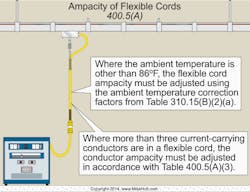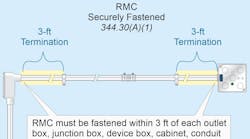Q. What are the ampacity requirements for flexible cords?
Find the Answer
A. Table 400.5(A)(1) lists the allowable ampacity for copper conductors in flexible cords and flexible cables and Table 400.5(A)(2) lists the allowable ampacity for copper conductors in flexible cords and flexible cables with not more than three current-carrying conductors at an ambient temperature of 86ºF [400.5(A)]. Where the number of current-carrying conductors in a cable or raceway exceeds three, the allowable ampacity of each conductor must be adjusted in accordance with the following multipliers:
|
Table 400.5(A)(3)(A)(3) Adjustment Factor |
|
|
Number of Current Carrying Conductors |
Multiplier |
|
4 to 6 |
0.80 |
|
7 to 9 |
0.70 |
|
10 to 20 |
0.50 |
If the ambient temperature is other than 86°F, the flexible cord or flexible cable ampacity, as listed in Table 400.5(A)(1) or 400.5(A)(2), must be adjusted by using the ambient temperature correction factors listed in Table 310.15(B)(2)(a) (see Figure).
Temperature ratings for flexible cords and flexible cables aren’t contained in the NEC, but UL listing standards state that flexible cords and flexible cables are rated for 60°C unless marked otherwise.
See 400.13 for overcurrent protection requirements for flexible cords and flexible cables.





